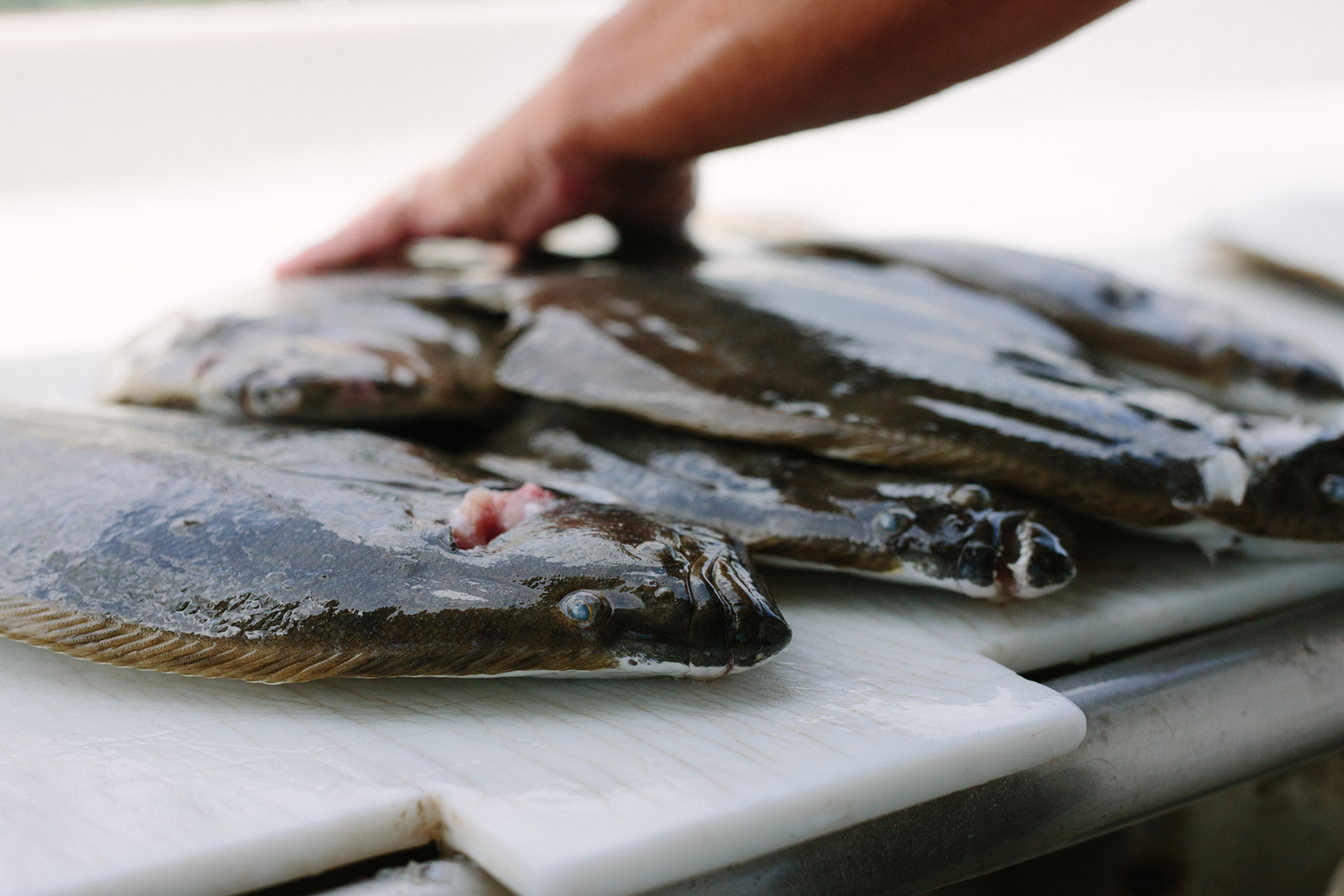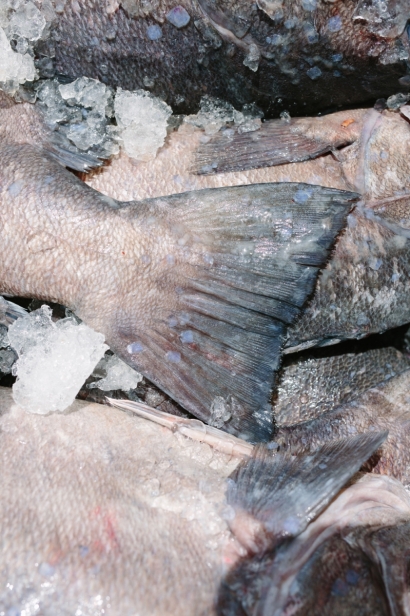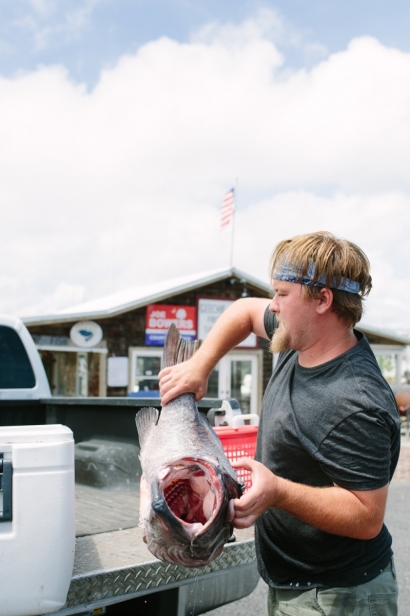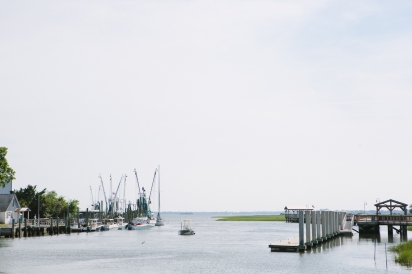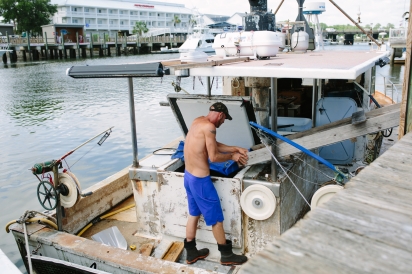The Reel Deal
A regal egret and a few wise felines play peek-a-boo in the marsh grass by Shem Creek’s Geechie Seafood Dock. They’re no fools. They see the customers lined up; they hear the scrape, scrape, scrape as Mark Marhefka’s tan, muscular arms send tiny silvery fish scales flying off the stainless-steel work table. They know, just as the folks in line do, that the freshest of fresh fish are being filleted, which means a few delicious scraps will eventually come their way. It’s just a matter of patience.
As a salty, seasoned, second-generation fisherman, Marhefka knows plenty about patience. He knows about waiting for storms to clear and tides to turn; about waiting for boat maintenance to be done and for business loans to come in. Mostly, he knows about waiting to get 70 miles offshore for several days at a time, then working, and waiting again, to find the right spot at the right time for fish to bite.
He knows, too, about the patience and diligence required to find the right market paying the right price to make the work he loves doing feasible. He has a family to support, and a conscience to keep clear—he’s passionate about fishing in a sustainable way: keeping fish stocks healthy, oceans healthy and fisher-folk working and earning a viable wage.
And when his last bit of patience on the sales side eventually ran thin, Marhefka and his wife, Kerry, decided to cut out the middle man and create their own market: Abundant Seafood, a community-supported fishery, or CSF, which operates on the same model as a CSA. The customers in line at the Geechie Dock are among their 400-plus Charleston-area Abundant Seafood members who have bought shares for the summer season, coming to pick up whatever Marhefka has just caught (snapper and grouper, this go-round). The cats, well, they’re just smart bystanders.
Speaking of smart, the Marhefkas are about as savvy as you get when it comes to all things finned and aquatic. The Mt. Pleasant couple met in the early 2000s when Kerry, a fisheries biologist, worked for South Atlantic Fishery Management Council—the regulatory body that oversees fishery stocks from the North Carolina/South Carolina border to Key West, and that occasionally tells fishermen where and what they can and can’t fish for. Mark was an advisory panel member, offering the council insight from the fisherman’s perspective.
“As an advisor I tried to be a voice for the public, representing seafood as a public resource,” he says, meanwhile Kerry “was making the laws I had to live by. Still does,” he jokes. Back then, though, “it was basically like sleeping with the enemy, as I call it.”
At the time, Marhefka was fishing in the traditional commercial model: going out for extended trips, catching as much as possible, coming in and selling the whole load to one fish house that set the price, then turning back around to do it all again. It was a game of volume played against time and elements—and those variables were often impossible to control.
When the fisheries management people, i.e., the Kerry’s of the world, periodically closed off grouper, for example, consumers were often clueless about why their favorite fish wasn’t on the restaurant menu.
“One of my goals in starting a CSF was to bridge that gap and give people direct access to fresh, quality fish, and help educate them as to why we might not have grouper—to explain the need behind closing fisheries to protect the stocks and have a balanced ocean,” he says. The other reason was pure economics: if there were limits to what he’d be able to catch, then Marhefka needed to be able to get a higher price for fewer fish.
Boat to Fork
Given their roles within fisheries management, “we could see the writing on the wall,” says Marhefka, who likes keeping a small, hands-on operation. He has a part-time captain who goes out every other trip of the Amy Marie. Their solution: make people value the product, and thereby be willing to pay a competitive price for quality, sustainably caught fish. That’s the essence of the Abundant Seafood model.
Marhefka began his direct-to-consumer efforts with Charleston-area chefs, and it turns out his timing was impeccable.
“You have to have a community where consumers demand the local product, and that’s not everywhere on the coast,” he says, and in addition, it has to be a community where not every other guy is out throwing a line to catch their own, he adds, noting that the plethora of recreational fishermen in Florida, for example, would make a similar model there more challenging.
“It was a perfect storm for us in Charleston,” says Marhefka, referring to the happy coincidence that the Holy City’s profile as a culinary hot spot was rising just as he launched Abundant Seafood.
“Sean (Brock), Mike (Lata) and Kevin (Johnson at The Grocery), Craig (Diehl at Cypress), Nico (then at Fish)—these were the guys who were the driving factor. FIG was my number one purchaser for a while,” he adds. Many of his chef connections were made through Megan Westmeyer, who at the time was heading up the South Carolina Aquarium’s Sustainable Seafood Initiative.
In 2010, he expanded the model to offer fresh fish twice a month to home cooks; initially some 70 locals were CSF members, today that number is five times that, and Marhefka is the main fish supplier for 30-some area restaurants, as well as a handful in the upstate. The business is relational, both the chefs and the CSF customers have come to know and trust the Marhefkas, and that means knowing and trusting that whatever Marhefka catches will be the freshest, beautifully handled fish.
And “whatever” means exactly that. Just as with a CSA, CSF customers and chefs get introduced to new varieties of fish.
“One of the unexpected benefits has been introducing certain species to chefs in town. The joke with amberjack used to be ‘put it on a cedar plank, grill it, then throw away the amberjack and keep the plank,’” Marhefka says. Because his handling of the fish is so gentle, and the quality uber-fresh, the chefs and diners both have a positive experience.
“Everybody is like, why have we been poo-pooing this fish?”
And when lesser-known fish are featured on menus and specials boards, the risk of overfishing the more popular species gets reduced, and the fishery stocks stay healthier.
Challenges Ahead
While the fish are abundant at the moment—“There are plenty of fish; somewhere in the ocean there’s a fish that wants to bite, just need to go find it,” Mark says—and the demand for his product by CSF community members and restaurants remains high, the economics of a small, sustainable business in an expensive real estate market remain tricky. Rental space for a Shem Creek boat slip for his trusty Amy Marie is high, and on a month-to-month basis, with no lease and no guarantees. And though they’d like to be able to open a retail outlet so the CSF customers can pick up fish at their convenience, the real estate prices are prohibitive.
“To do the things the right way is hard. We’re looking at five to seven thousand dollars a month to stay in a building, which is that much more fish to have to pass through my cutting table.”
And the Marhefkas remain committed to doing things the right way, which, in addition to delivering only the best-quality fish means streamlining the customer service experience. Their recently upgraded website allows members to more easily keep track of their shares and pick-ups. But maintaining the balance between staying small and providing direct-to-consumer service and meeting growing CSF demand remains tenuous.
“I simply don’t catch enough to keep everybody happy,” Marhefka says. “My chefs, like Jason Stanhope at FIG, are like, ‘whatever Mark brings, that’s great, that’s how we manipulate the menu.’ But managing the CSF customer is the most challenging part right now.”
Some people will try to haggle; a few may be disappointed when a filleted triggerfish yields only a third of what they’d hoped. (Abundant Seafood shares are sold by the pound, before the fish is cut.)
“The price of the fish is the price of the fish,” says Marhefka, who knows well, as do the majority of his very happy customers, how much work has gone into catching and caring for that fish.
Passion Powered
“Fishing is hard, it costs a lot of money for us to do what we’ve got to do. It’s hard to find good help, and it’s hard to have to leave your home and family for days or weeks at a time. It’s not a 9-to-5 thing—not a day-boat thing,” he says. Regardless, it’s a way of life and work that he and Kerry remain anchors-away enthusiastic about.
“I’m just passionate. Passionate about the fish, and about the whole idea that it’s a public resource and honoring it in the proper way,” he says. “That fish gave its life so we can enjoy it and be fed by it.” This passion extends beyond taking good care of the fish they catch and their customers, to caring for the ocean and marine environment. Kerry will likely soon rotate back on the Fisheries Management advisory board, and she’s active in lobbying against threats like offshore drilling.
“She’s gone to Washington, D.C., to talk to Senator Tim Scott about that, getting our chefs with their political clout to chime in. I think he got it when Chef Mike Lata said, ‘if Mark can’t stay sustainable, then we can’t stay sustainable.’”
The sustainability factor has always been central to the Marhefkas’ business model. Offering fresh, locally and sustainably caught fish direct to chefs and CSF patrons not only makes their livelihood as fishermen more sustainable, it’s healthier for the oceans and the fishery stocks. All fish carcasses go to the compost pile at Rebellion Farm on Johns Island after a CSF customer pick-up.
“And when I’m dropping off fish at FIG and see the Rebellion Farm truck there delivering locally grown vegetables that will be served alongside my fish, well,” the fisherman says, “that’s an awesome full-circle feeling.”
LocalCatch.org is a website that geo-locates Community Supported Fisheries around the country. Currently Abundant Seafood is the only one listed in South Carolina. “I’m still a lone ranger around here,” owner Mark Marhefka says. He’s proud that Abundant Seafood abides by the following Local Catch “core values”:
-
Catch and handle with honor
-
Community- and ecosystem-based fisheries management
-
Community-based fisheries
-
Creative and collaborative
-
Eating within the ecosystem
-
Fair access
-
Fair price
-
Honor the ocean
-
Traceable and simple supply chain


